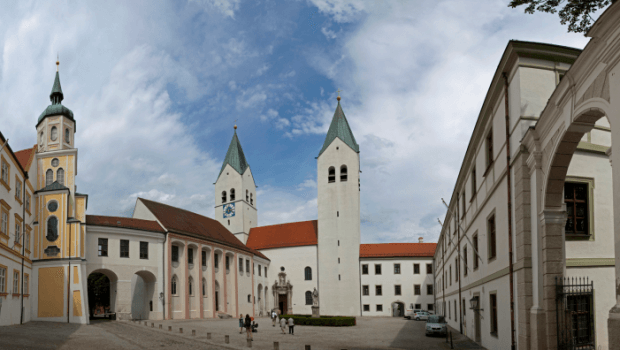
Freising Kathedrale: The Co-Cathedral of the Catholic Archdiocese of Freising and Munich
The Freising Cathedral is also sometimes known by the name of Corbinian and Saint Mary Cathedral. This cathedral is located in the city of Freising and is built in Romanesque architecture. Freising is located in the German city of Bavaria. The Freising Cathedral is a co-cathedral belonging to the Catholic Archdiocese of Freising and Munich. This place is widely popular, as this is the same spot where Pope Benedict the Sixteenth was ordained to be a priest.
History of Freising Cathedral
In the year 715 AD, it is speculated that an early church stood at this very same spot. This church was consecrated as an episcopal church by Saint Boniface in the year 739 AD. In the year 860 AD, three naves were added to the church, which was later rebuilt in the year 903 AD. The rebuilding process took place as the church was caught in a bad fire. This was not the only fire incident that took place in the church. On the 5th of April, in the year 1205, on the occasion of Palm Sunday, this beautiful church was burnt to the ground. Thus the construction of this church built in Romanesque architecture began in the year 1159. The construction of the church was completed in the year 1205. From the years 1481 to 1483, the Romanesque ceilings built completely out of wood was replaced by a vault made in gothic architecture.
Located within the four nave crypt of this cathedral is the tomb of the patron saint of Catholic Archdiocese of Freising and Munich, Saint Corbinian. The Pillar of the Beasts or the Bestiensaule is located in the middle of this crypt. This sculpture is renowned in the whole of Europe for its beauty and was built during the high Middle Ages.
From the start of the year 1619, and the beginning of Baroque architectural period, there was a considerable amount of reconstruction which took place at this very site. The complete refurbishment of this church was undertaken in the year 1621 and on the 1st of January, in the year 1624, the high altar was consecrated in the church.
One of the most striking features of this church is the beautifully painted altarpiece. The elaborate altarpiece aptly matches its vibrant history attached to it. In the year 1623, the Prince-Bishop of Freising, Veit Adam Gebeck commissioned the famous Hans Rottenhammer to complete the designing of the altar. However, it is believed that Rottenhammer was an alcoholic and the work got indefinitely delayed due to his drinking habits. In an unknown period of time, the work was transferred into the hands of Rubens who went on to finish this project. Rubens, adhering to the fifteenth century German trends, added the Woman of the Apocalypse into the altar. The bishop then commissioned a painting depicting the Blessed Virgin, which rendered the Madonna of Revelation being associated with Immaculate Conception and the Assumption of Virgin. It is interesting to note that the finished painting’s first mention dates back to the year 1632 when the Swedish troops were advancing on the city and the painting was evacuated from the site. Today this painting is kept in the German city of Munich, located at the Alte Pinakothek.
The church’s thousandth anniversary was celebrated din the year 1724, and keeping in view the same, another refurbishment project was undertaken. Today the beautiful Rocco design church is attributed to both Egid Asam and Cosmas Asam. In the year 2006, restoration of the damaged frescoes within the church was conducted.
Important Figures Related to the Freising Kathedrale
- Archdiocese of Munich and Freising
The Archdiocese of Munich and Freising is a diocese or an ecclesiastical region belonging to the Roman Catholic Church of the German city of Bavaria. This is governed under the leadership of the Munich’s Archbishop, who oversees the place from the co- cathedral located in the city of Munich. The second and the much older cathedral is located in Freising and is known by the name of the Freising Cathedral.
This was erected in the year 739 by a saint named Boniface as a diocese. Although, as time passed on it became a prince-bishopric. After the collapse of the Holy Roman Empire, the diocese ceased to exist in the year 1803. Although, until the year 1818, a titular bishop oversaw this diocese. This was done, as the Pope Pius the Seventh had elevated the status to archdiocese from only being a diocese. The holy seat was then transferred from Freising to Munich.
This archdiocese is distinguished into 40 deaneries with over 750 parishes. The suffragan bishops of this place are the Regensburg Bishop, Passau Bishop and the Augsburg Bishop.
Pope Benedict the Sixteenth, who was earlier known as Joseph Ratzinger, was an archbishop here. The dwelling of the Archbishops of Munich and Freising is located in the Palais Holnstein in the German city of Munich.
- The Virgin Mary
Mary or the Virgin Mary is known by numerous honorifics, titles and styles, was a Galilean Jewish, belonging to the first century. According to the New Testament, she belonged to the city of Nazareth and was the mother of Jesus.
The gospels, said to have been written by Luke and Matthew, states that Mary was a Virgin and the Christians popularly believe that Jesus was conceived by her through the Holy Spirit. This bird, branded as miraculous in nature, took place when she was already married to Joseph. After marriage, she accompanied her husband to the city of Bethlehem, where it is said that Jesus was born.
In Christianity, she is known by names of the Blessed Virgin Mary, Saint Mary, the Mother of God, Theotokos (bearer of God), Our Lady or the Queen of Heaven.
Apart from Christians, she is also popular in the Islam and is often referred by the name of Maryam.
- Saint Corbinian
Saint Corbinian who lived from the years 670 to 730 AD, is believed to be a Frankish Bishop. He used to dwell in the region of Chartes for about fourteen years in a hermitage. He then moved to the Holy city of Rome, where Pope Gregory the Second had sent him to the German city of Bavaria. Here he was sent to exile as he opposed the marriage of Duke Grimoald with Biltrudis, who was the Duke’s brother’s widow. 8th of September every year is celebrated as his feast day.
- Woman of the Apocalypse
The depiction of a Woman clothed with the sun or the Woman of the Apocalypse is a central figure from the Book of Revelation, chapter twelve, which is said to have been written in 95 AD.
Within the narrative of chapter 12, she is said to have given broth to a boy who is then attacked by a Dragon. The Dragon is said to have been Satan and Devil himself. The child is then taken to heaven, while the woman flees to the jungles. This leads to a war taken place in heaven itself. In this war, the dragon is cast out of heaven by the angels. The dragon follows the woman, while the angels help the woman by giving her wings to fly. The dragon then produces flood from its mouth, to which the earth comes to the woman’s aid. The dragon infuriated now wages a war against the followers of the Christ in order to take his revenge.
In popular mythology, this woman is paralleled with the Virgin Mary herself. This interpretation of the Woman of the Apocalypse is help by the ancient, modern and medieval Roman Catholic Church. The modern interpretation, however, seems to differ a little, as the woman here is representative of the Catholic dogma or the Church itself. However, it is important to note that Mary herself is considered as the Mother of Church and the Mother of the God.
More about Freising
Freising is a little town in the German state of Bavaria. It is also the capital city of the Freising district. The town has a total of over forty thousand inhabitants. The town of Freising is located to the northern side of the city of Munich and is located near the River Isar. This town is also closely situated to the International Airport of Munich. If you are on a plane from this airport, then you can easily locate the Weihenstephan Hill and the Cathedral of Freising.
This town is one of the oldest settlements in the German region of Bavaria. During the middle ages, this place gained popularity in Germany and other European countries, becoming one of the most important religious centre. Between the year 900 and 1200 AD, some of the most important documents were written in this place. First was the Freising manuscript which is written in the Slovenian language and is the first of the Roman script written in the Slavic language. Second is the history or chronicle of the cities written by Otto from the Freising town. If you want to have a look at these manuscripts, then these are located at the Bavarian State Library in the German city of Munich.
If you are here in the town of Freising then do have a look at these places:
– The Freising Cathedral
– The inside of the Freising Cathedral
– Saint Georg’s Church
– The Bishop’s Castle
– The Monastery Neustift
– The Asam theatre
– The Weihenstephan brewery
– The Hofbrauhaus brewery
